Laser Cavitation Peening: A Review
Abstract
Featured Application
Abstract
1. Introduction
2. Peening Using a Pulsed Laser
2.1. Laser Peening Underwater (Laser Cavitation Peening) and Laser Peening with a Water Film
2.2. Laser Cavitation Peening System
3. Comparison between Laser Ablation and Laser Cavitation
4. Key Factors of Laser Cavitation Peening
4.1. Overview of Key Factors of Laser Cavitation Peening
4.2. Bubble Size
4.3. Bubble Shape
4.4. Water Quality
4.5. Peening Pattern
5. Improvement of Fatigue Properties of Metals via Laser Cavitation Peening
| Material | Fatigue Test | Fatigue Strength at 107 | References | ||
|---|---|---|---|---|---|
| Non-Peened | Laser Cavitation Peening | Shot Peening | |||
| AM (EBM) titanium alloy Ti6Al4V | Plane bending | 169 MPa | 317 MPa | 335 MPa | [7] |
| AM (DMLS) titanium alloy Ti6Al4V | Plane bending | 185 MPa | 357 MPa | 355 MPa | [64] |
| AM (DMLS) titanium alloy Ti6Al4V | Torsion | 217 MPa | 361 MPa | 285 MPa | [65] |
| Magnesium alloy AZ31 | Plane bending | 97 MPa | 151 MPa | 112 MPa | [66] |
| Stainless-steel 316L | Plane bending | 279 MPa | 272 MPa | 305 MPa | [20] |
| Stainless-steel 316L (welded) | Plane bending | 188 MPa | 300 MPa | 260 MPa | [16] |
6. Future Work
7. Conclusions
- (1)
- During submerged laser peening, the impact of laser cavitation, which is generated after laser ablation, can be utilized for mechanical surface treatment. This is referred to as laser cavitation peening. Water quality, such as gas content, is an important factor, as the cavitation bubble collapse impact is affected by the gas content; this is called the cushion effect.
- (2)
- The impact passing through the target of laser cavitation collapse is greater than that of laser ablation, although the amplitude of the shockwave in water induced by laser ablation is larger than that of laser cavitation collapse.
- (3)
- A hemispherical bubble is most effective for laser cavitation peening compared with a spherical bubble, which produces a microjet in the bubble.
- (4)
- In the case of laser cavitation peening, the peening intensity is proportional to the volume of laser cavitation when the threshold of the target materials is considered.
- (5)
- During laser cavitation peening, the area near the edge can be treated using laser cavitation, which develops and collapses near the edge.
- (6)
- Laser cavitation peening improves the fatigue strength of metallic materials, including three-dimensional additively manufactured metals (3D metals). In the case of magnesium alloy AZ31, the fatigue strength at N = 107 evaluated by a plane bending fatigue test was 151 MPa for laser cavitation peening, 112 MPa for shot peening, and 97 MPa for non-peened. In the case of additively manufactured Ti6Al4V by DMLS, the fatigue strength at N = 107 evaluated by a torsion fatigue test was 361 MPa for laser cavitation peening, 285 MPa for shot peening, and 217 MPa for non-peened.
Author Contributions
Funding
Institutional Review Board Statement
Informed Consent Statement
Data Availability Statement
Conflicts of Interest
References
- Wagner, L. Mechanical surface treatments on titanium, aluminum and magnesium alloys. Mater. Sci. Eng. A 1999, 263, 210–216. [Google Scholar] [CrossRef]
- Wang, P.; Li, X.; Luo, S.; Nai, M.L.S.; Ding, J.; Wei, J. Additively manufactured heterogeneously porous metallic bone with biostructural functions and bone-like mechanical properties. J. Mater. Sci. Technol. 2021, 62, 173–179. [Google Scholar] [CrossRef]
- Edwards, P.; O’Conner, A.; Ramulu, M. Electron beam additive manufacturing of titanium components: Properties and performance. J. Manuf. Sci. Eng. 2013, 135, 061016. [Google Scholar] [CrossRef]
- Peyre, P.; Fabbro, R.; Merrien, P.; Lieurade, H.P. Laser shock processing of aluminium alloys. Application to high cycle fatigue behaviour. Mater. Sci. Eng. A 1996, 210, 102–113. [Google Scholar] [CrossRef]
- Sano, Y. Quarter century development of laser peening without coating. Metals 2020, 10, 152. [Google Scholar] [CrossRef]
- Soyama, H.; Korsunsky, A.M. A critical comparative review of cavitation peening and other surface peening methods. J. Mater. Process. Technol. 2022, 305, 117586. [Google Scholar] [CrossRef]
- Soyama, H.; Okura, Y. The use of various peening methods to improve the fatigue strength of titanium alloy Ti6Al4V manufactured by electron beam melting. AIMS Mater. Sci. 2018, 5, 1000–1015. [Google Scholar] [CrossRef]
- Hackel, L.; Rankin, J.R.; Rubenchik, A.; King, W.E.; Matthews, M. Laser peening: A tool for additive manufacturing post-processing. Addit. Manuf. 2018, 24, 67–75. [Google Scholar] [CrossRef]
- Kahlin, M.; Ansell, H.; Basu, D.; Kerwin, A.; Newton, L.; Smith, B.; Moverare, J.J. Improved fatigue strength of additively manufactured Ti6Al4V by surface post processing. Int. J. Fatigue 2020, 134, 105497. [Google Scholar] [CrossRef]
- Kuji, C.; Soyama, H. Mechanical surface treatment of titanium alloy Ti6Al4V manufactured by direct metal laser sintering using laser cavitation. Metals 2023, 13, 181. [Google Scholar] [CrossRef]
- Sano, Y.; Obata, M.; Kubo, T.; Mukai, N.; Yoda, M.; Masaki, K.; Ochi, Y. Retardation of crack initiation and growth in austenitic stainless steels by laser peening without protective coating. Mater. Sci. Eng. A 2006, 417, 334–340. [Google Scholar] [CrossRef]
- Mao, B.; Siddaiah, A.; Menezes, P.L.; Liao, Y.L. Surface texturing by indirect laser shock surface patterning for manipulated friction coefficient. J. Mater. Process. Technol. 2018, 257, 227–233. [Google Scholar] [CrossRef]
- Kawashima, T.; Sano, T.; Hirose, A.; Tsutsumi, S.; Masaki, K.; Arakawa, K.; Hori, H. Femtosecond laser peening of friction stir welded 7075-T73 aluminum alloys. J. Mater. Process. Technol. 2018, 262, 111–122. [Google Scholar] [CrossRef]
- Yoshida, M.; Nishibata, I.; Matsuda, T.; Ito, Y.; Sugita, N.; Shiro, A.; Shobu, T.; Arakawa, K.; Hirose, A.; Sano, T. Influence of pulse duration on mechanical properties and dislocation density of dry laser peened aluminum alloy using ultrashort pulsed laser-driven shock wave. J. Appl. Phys. 2022, 132, 075101. [Google Scholar] [CrossRef]
- Sano, Y.; Akita, K.; Sano, T. A mechanism for inducing compressive residual stresses on a surface by laser peening without coating. Metals 2020, 10, 816. [Google Scholar]
- Soyama, H. Laser cavitation peening and its application for improving the fatigue strength of welded parts. Metals 2021, 11, 531. [Google Scholar] [CrossRef]
- Gu, J.Y.; Luo, C.H.; Ma, P.C.A.; Xu, X.C.; Wu, Y.; Ren, X.D. Study on processing and strengthening mechanisms of mild steel subjected to laser cavitation peening. Appl. Surf. Sci. 2021, 562, 150242. [Google Scholar]
- Sasoh, A.; Watanabe, K.; Sano, Y.; Mukai, N. Behavior of bubbles induced by the interaction of a laser pulse with a metal plate in water. Appl. Phys. A 2005, 80, 1497–1500. [Google Scholar]
- Soyama, H. Key factors and applications of cavitation peening. Inter. J. Peen. Sci. Technol. 2017, 1, 3–60. [Google Scholar]
- Soyama, H. Comparison between the improvements made to the fatigue strength of stainless steel by cavitation peening, water jet peening, shot peening and laser peening. J. Mater. Process. Technol. 2019, 269, 65–78. [Google Scholar] [CrossRef]
- Soyama, H.; Sekine, Y.; Saito, K. Evaluation of the enhanced cavitation impact energy using a pvdf transducer with an acrylic resin backing. Measurement 2011, 44, 1279–1283. [Google Scholar] [CrossRef]
- Glaser, D.; Polese, C. Cavitation bubble oscillation period as a process diagnostic during the laser shock peening process. Appl. Phys. A 2017, 123, 603. [Google Scholar] [CrossRef]
- Ren, X.D.; Wang, J.; Yuan, S.Q.; Adu-Gyamfi, S.; Tong, Y.Q.; Zuo, C.Y.; Zhang, H.F. Mechanical effect of laser-induced cavitation bubble of 2a02 alloy. Opt. Laser Technol. 2018, 105, 180–184. [Google Scholar] [CrossRef]
- Saitou, N.; Enomoto, K.; Kurosawa, K.; Morinaka, R.; Hayashi, E.; Ishikwa, T.; Yoshimura, T. Development of water jet peening technique for reactor internal components of nuclear power plant. J. Jet Flow Eng. 2003, 20, 4–12. [Google Scholar]
- Soyama, H. Cavitating jet: A review. Applied Sciences 2020, 10, 7280. [Google Scholar] [CrossRef]
- Plesset, M.S.; Chapman, R.B. Collapse of an initially spherical vapour cavity in neighbourhood of a solid boundary. J. Fluid Mech. 1971, 47, 283–290. [Google Scholar]
- Lauterborn, W.; Bolle, H. Experimental investigations of cavitation-bubble collapse in neighborhood of a solid boundary. J. Fluid Mech. 1975, 72, 391–399. [Google Scholar] [CrossRef]
- Crum, L.A. Surface oscillations and jet development in pulsating bubbles. J. Phys. Colloques 1979, 40, 285–288. [Google Scholar] [CrossRef]
- Brennen, C.E. Cavitation and Bubble Dynamics; Oxford University Press: Oxford, UK, 1995. [Google Scholar]
- Ley, S.V.; Low, C.M.R. Ultrasound in Synthesis; Springer: Berlin, Germany, 1980. [Google Scholar]
- Gonzalez-Avila, S.R.; Denner, F.; Ohl, C.-D. The acoustic pressure generated by the cavitation bubble expansion and collapse near a rigid wall. Phys. Fluids 2021, 33, 032118. [Google Scholar] [CrossRef]
- Park, S.-H.; Phan, T.-H.; Park, W.-G. Numerical investigation of laser-induced cavitation bubble dynamics near a rigid surface based on three-dimensional fully compressible model. Inter. J. Heat and Mass Transfer 2022, 191, 122853. [Google Scholar] [CrossRef]
- Sun, Y.; Du, Y.; Yao, Z.; Zhong, Q.; Geng, S.; Wang, F. The effect of surface geometry of solid wall on the collapse of a cavitation bubble. J. Fluids Eng. 2022, 144, 071402. [Google Scholar] [CrossRef]
- Sieber, A.B.; Preso, D.B.; Farhat, M. Cavitation bubble dynamics and microjet atomization near tissue-mimicking materials. Phys. Fluids 2023, 35, 027101. [Google Scholar] [CrossRef]
- Iga, Y.; Sasaki, H. Relationship between a non-spherical collapse of a bubble and a stress state inside a wall. Phys. Fluids 2023, 35, 023312. [Google Scholar] [CrossRef]
- Hatamleh, O.; Lyons, J.; Forman, R. Laser and shot peening effects on fatigue crack growth in friction stir welded 7075-T7351 aluminum alloy joints. Int. J. Fatigue 2007, 29, 421–434. [Google Scholar] [CrossRef]
- Gill, A.; Telang, A.; Mannava, S.R.; Qian, D.; Pyoun, Y.-S.; Soyama, H.; Vasudevan, V.K. Comparison of mechanisms of advanced mechanical surface treatments in nickel-based superalloy. Mater. Sci. Eng. A 2013, 576, 346–355. [Google Scholar] [CrossRef]
- Philipp, A.; Lauterborn, W. Cavitation erosion by single laser-produced bubbles. J. Fluid Mech. 1998, 361, 75–116. [Google Scholar] [CrossRef]
- Soyama, H. Introduction of Compressive Residual Stress into Alloy Tool Steel by Submerged Laser Peening Utilizing Laser Cavitation Impact. In Proceedings of the International Conference on Leading Edge Manufacturing in 21st Century: LEM21 2017.9; 2017; Volume 9, p. 10. Available online: https://www.jstage.jst.go.jp/article/jsmelem/2017.9/0/2017.9_010/_article/-char/ja/ (accessed on 23 April 2023).
- Sano, Y.; Kato, T.; Mizuta, Y.; Tamaki, S.; Yokofujita, K.; Taira, T.; Hosokai, T.; Sakino, Y. Development of a portable laser peening device and its effect on the fatigue properties of HT780 butt-welded joints. Forces Mech. 2022, 7, 100080. [Google Scholar] [CrossRef]
- Kang, C.; Liu, H.X.; Soyama, H. Estimation of aggressive intensity of a cavitating jet with multiple experimental methods. Wear 2018, 394, 176–186. [Google Scholar] [CrossRef]
- Noor Shahira Masroon, N.S.; Hirata, H.; Tsuyama, M.; Heya, M.; Nakano, H. Effects of laser peening parameters on plastic deformation in aqueous glycerol solution as plasma confinement layer. J. Laser Micro/Nanoeng. 2021, 16, 160–165. [Google Scholar]
- Soyama, H.; Kokubun, T. Effect of impact induced by cavitation bubble on submerged laser peening. J. Shot Peening Technol. Japan 2016, 28, 48–49. [Google Scholar]
- J442_202205; Test Strip, Holder, and Gage for Shot Peening. SAE International Standards: Warrendale, PA, USA, 2013; pp. 1–5.
- J443_201708; Procedures for Using Standard Shot Peening Almen Strip. SAE International Standards: Warrendale, PA, USA, 2010; pp. 1–6.
- Soyama, H. Cavitation peening: A review. Metals 2020, 10, 270. [Google Scholar] [CrossRef]
- Soyama, H. Comparison between impact induced by abrasion and bubble collapse impact on laser peening. Proc. Mechanica Eng. Congr. 2016, 16, G0400402. [Google Scholar] [CrossRef]
- Soyama, H.; Yahata, Y.; Saito, M. Aspect of bubbles in narrow tube imitating root canal induced by er: Yag laser. In Proceedings of the 11th International Symposium on Cavitation, Virtual, 10–13 May 2021; pp. 229–232. [Google Scholar]
- Sugimoto, Y.; Obata, S. Behavior of a sphere caused by pulsed laser induced bubble simulating stone crushing with TUL. Proc. 11th Inter. Sympo. Cavitation 2021, 614–617. [Google Scholar]
- Nguyen, T.T.P.; Tanabe, R.; Ito, Y. Influences of focusing conditions on dynamics of laser ablation at a solid–liquid interface. Appl. Phys. Express 2013, 6, 122701. [Google Scholar] [CrossRef]
- Soyama, H. Comparison between shot peening, cavitation peening and laser peening by observation of crack initiation and crack growth in stainless steel. Metals 2020, 10, 63. [Google Scholar] [CrossRef]
- Lauterborn, W.; Ohl, C.D. Cavitation bubble dynamics. Ultrason. Sonochem. 1997, 4, 65–75. [Google Scholar] [CrossRef] [PubMed]
- Ohl, C.D.; Lindau, O.; Lauterborn, W. Luminescence from spherically and aspherically collapsing laser induced bubbles. Phys. Rev. Lett. 1998, 80, 393–396. [Google Scholar] [CrossRef]
- Ohl, C.D.; Kurz, T.; Geisler, R.; Lindau, O.; Lauterborn, W. Bubble dynamics, shock waves and sonoluminescence. Philos. Trans. R. Soc. A 1999, 357, 269–294. [Google Scholar] [CrossRef]
- Soyama, H. Luminescence intensity of vortex cavitation in a venturi tube changing with cavitation number. Ultrason. Sonochem. 2021, 71, 105389. [Google Scholar] [CrossRef] [PubMed]
- Rayleigh, L. On the pressure developed in a liquid during the collapse of a spherical cavity. Lond. Edinb. Dublin Philos. Mag. J. Sci. 1917, 34, 94–98. [Google Scholar] [CrossRef]
- Soyama, H.; Kuji, C.; Kuriyagawa, T.; Chighizola, C.R.; Hill, M.R. Optimization of residual stress measurement conditions for a 2D method using X-ray diffraction and its application for stainless steel treated by laser cavitation peening. Materials 2021, 14, 2772. [Google Scholar] [CrossRef] [PubMed]
- Soyama, H. Surface mechanics design by cavitation peening using submerged pulse laser. In Proceedings of the Abstracts of 7th International Conference on Laser Peening and Related Phenomena, Singapore, 17–22 June 2018; p. 57. [Google Scholar]
- Soyama, H. Introduction of compressive residual stress into stainless steel by bubble induced by submerged pulse laser. J. Shot Peening Technol. Japan 2019, 31, 86–87. [Google Scholar]
- Soyama, H.; Kuji, C. Improving effects of cavitation peening, using a pulsed laser or a cavitating jet, and shot peening on the fatigue properties of additively manufactured titanium alloy Ti6Al4V. Surf. Coat. Technol. 2022, 451, 129047. [Google Scholar] [CrossRef]
- Khorasani, M.; Gibson, I.; Ghasemi, A.H.; Hadavi, E.; Rolfe, B. Laser subtractive and laser powder bed fusion of metals: Review of process and production features. Rapid Prototyp. J. 2023, 29, 935–958. [Google Scholar] [CrossRef]
- Little, R.E. Estimating the median fatigue limit for very small up-and-down quantal response tests and for S-N data with runouts. ASTM STP 1972, 511, 29–42. [Google Scholar]
- Kumagai, M.; Curd, M.E.; Soyama, H.; Ungár, T.; Ribárik, G.; Withers, P.J. Depth-profiling of residual stress and microstructure for austenitic stainless steel surface treated by cavitation, shot and laser peening. Mater. Sci. Eng. A 2021, 813, 141037. [Google Scholar] [CrossRef]
- Soyama, H.; Takeo, F. Effect of various peening methods on the fatigue properties of titanium alloy Ti6Al4V manufactured by direct metal laser sintering and electron beam melting. Materials 2020, 13, 2216. [Google Scholar] [CrossRef] [PubMed]
- Soyama, H.; Kuji, C. Comparison on fatigue strength of additive manufactured titanium alloy by various peening methods. In Proceedings of the Annual Meeting Society Materials Science Japan, Tsukuba, Japan, 29–30 May 2023; Volume 72. [Google Scholar]
- Soyama, H.; Kuji, C.; Liao, Y. Comparison of the effects of submerged laser peening, cavitation peening and shot peening on the improvement of the fatigue strength of magnesium alloy AZ31. J. Magnes. Alloy. 2023, 11. [Google Scholar] [CrossRef]
- Munoz-Cubillos, J.; Coronado, J.J.; Rodriguez, S.A. Deep rolling effect on fatigue behavior of austenitic stainless steels. Int. J. Fatigue 2017, 95, 120–131. [Google Scholar] [CrossRef]
- Zhou, J.; Retraint, D.; Sun, Z.; Kanoute, P. Comparative study of the effects of surface mechanical attrition treatment and conventional shot peening on low cycle fatigue of a 316L stainless steel. Surf. Coat. Technol. 2018, 349, 556–566. [Google Scholar] [CrossRef]
- Telang, A.; Gnaupel-Herold, T.; Gill, A.; Vasudevan, V.K. Effect of applied stress and temperature on residual stresses induced by peening surface treatments in alloy. J. Mater. Eng. Perform. 2018, 27, 2796–2804. [Google Scholar] [CrossRef]
- Ben Moussa, N.; Gharbi, K.; Chaieb, I.; Ben Fredj, N. Improvement of AISI 304 austenitic stainless steel low-cycle fatigue life by initial and intermittent deep rolling. Int. J. Adv. Manuf. Technol. 2019, 101, 435–449. [Google Scholar] [CrossRef]
- Yang, S.; Zeng, W.; Yang, J. Characterization of shot peening properties and modelling on the fatigue performance of 304 austenitic stainless steel. Int. J. Fatigue 2020, 137, 105621. [Google Scholar] [CrossRef]
- Soyama, H.; Chighizola, C.R.; Hill, M.R. Effect of compressive residual stress introduced by cavitation peening and shot peening on the improvement of fatigue strength of stainless steel. J. Mater. Process. Technol. 2021, 288, 116877. [Google Scholar] [CrossRef]
- Soyama, H. Laser cavitation peening using a Nd: YAG laser with and without Q-switch. In Abstracts of Quantum Beam Application for Sciences and Industries; 2023; p. 51. Available online: https://qbasis2023.isir-sanken.jp/QBASIS2023/wp-content/uploads/2023/05/Q-BASIS-2023_Abstract_finalver.pdf (accessed on 28 April 2023).
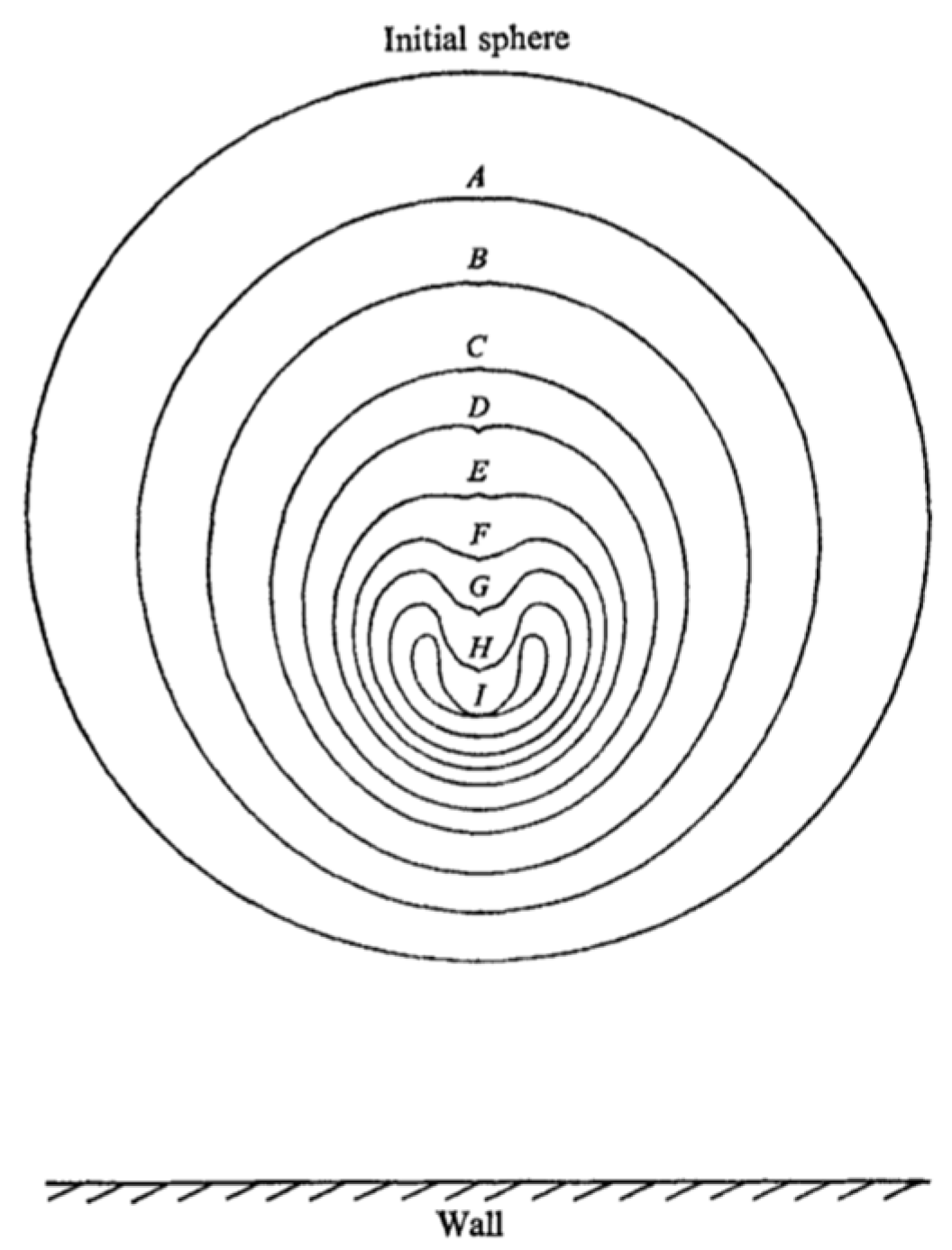
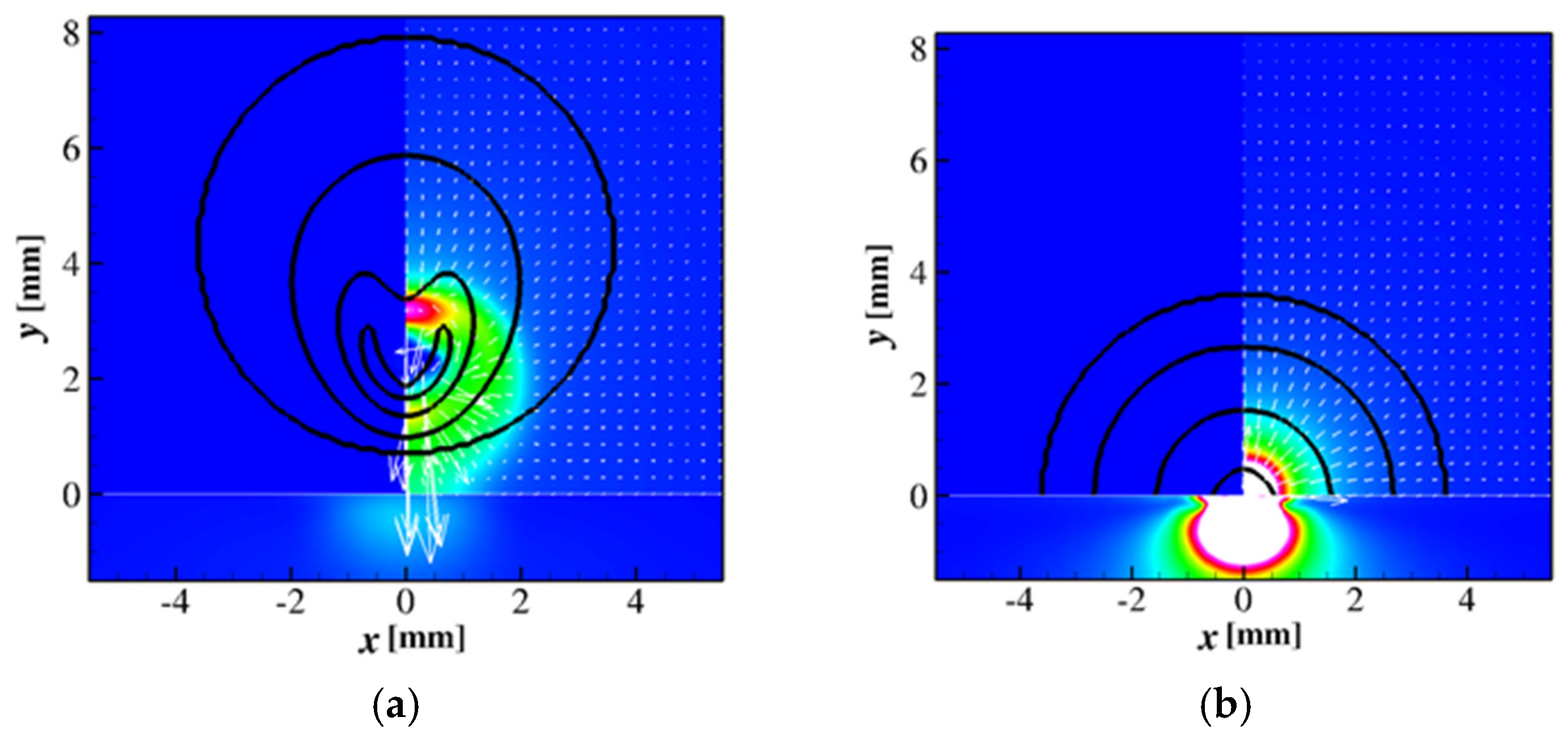

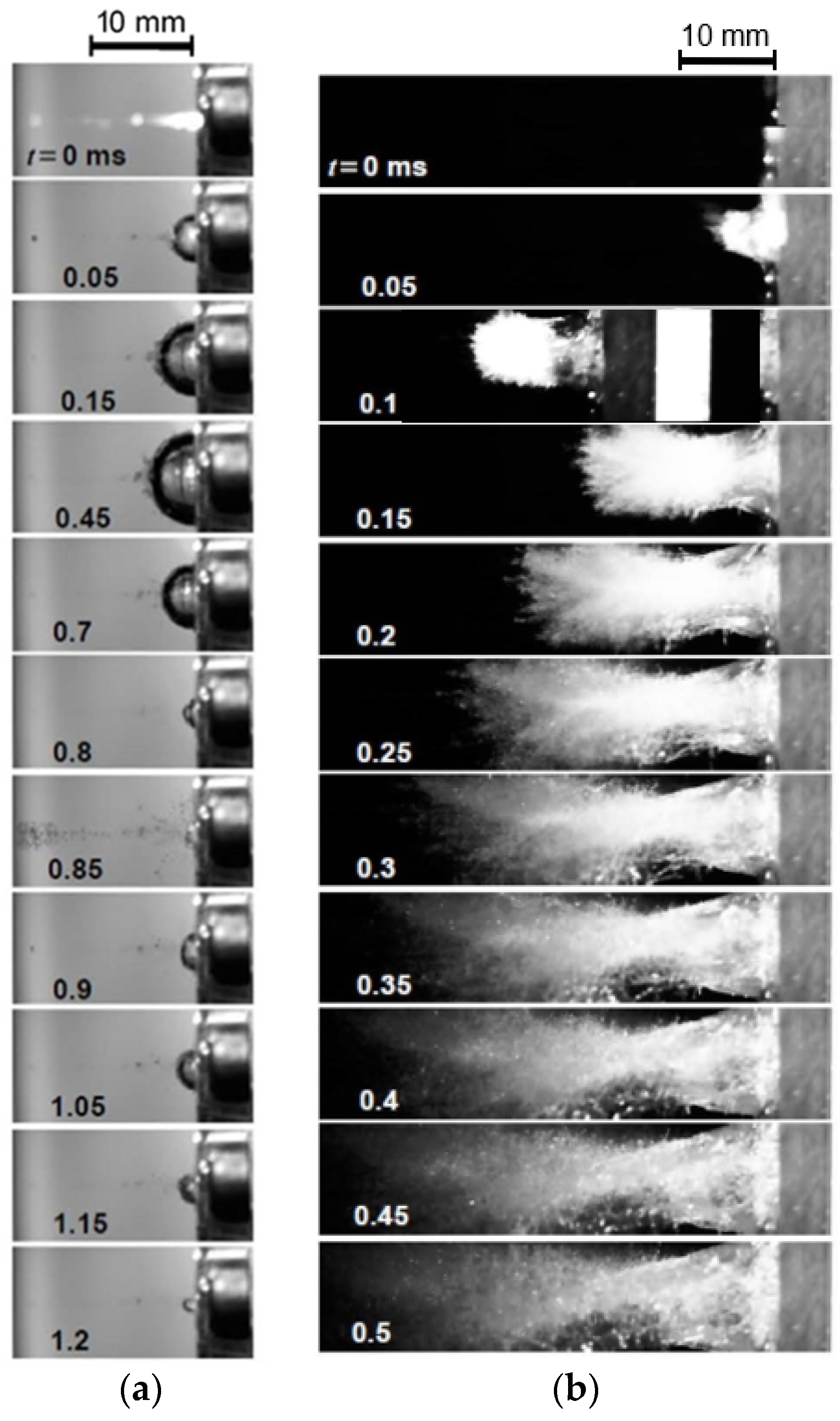


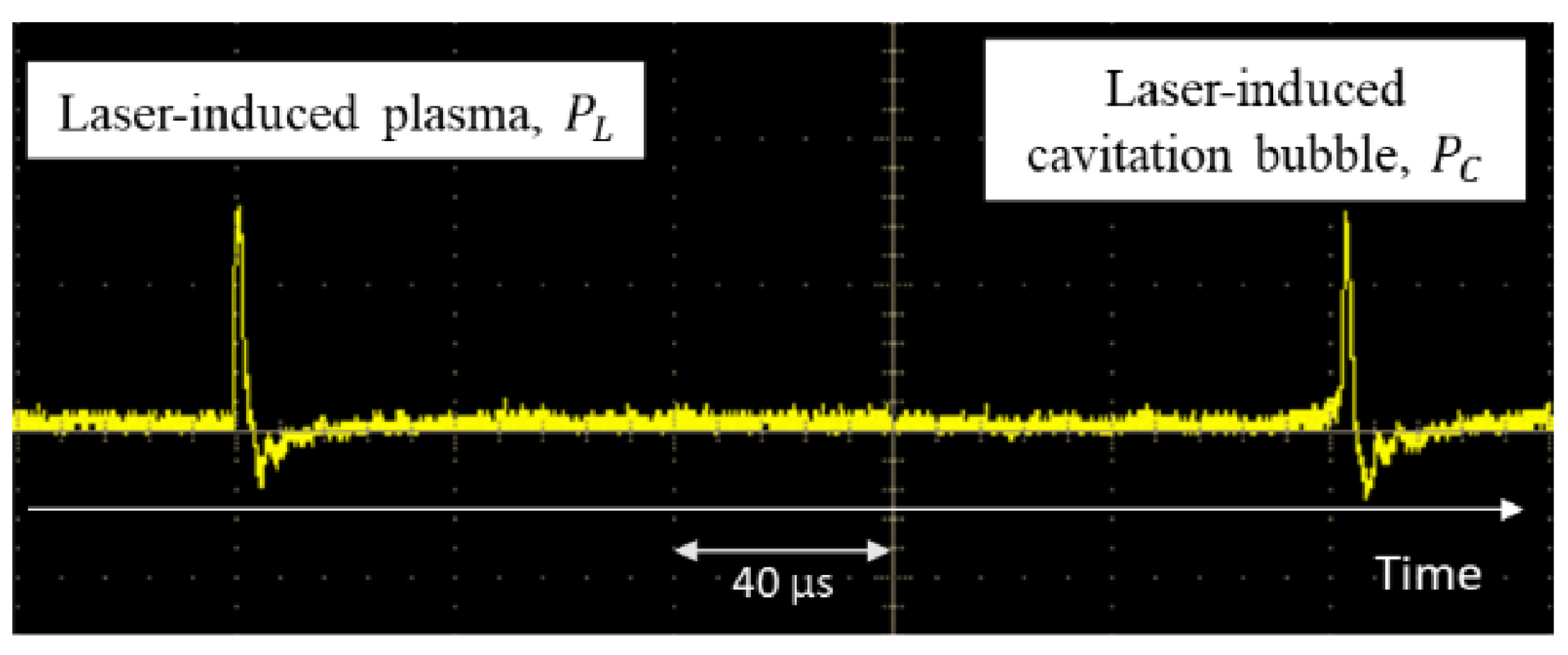
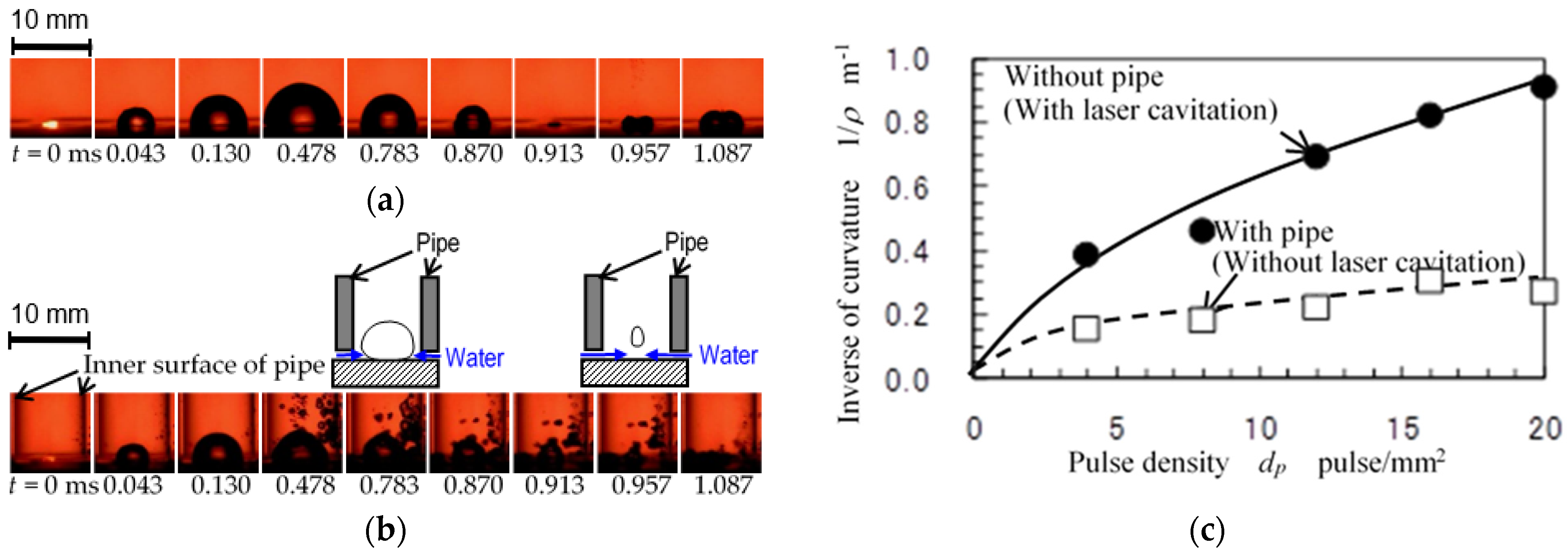

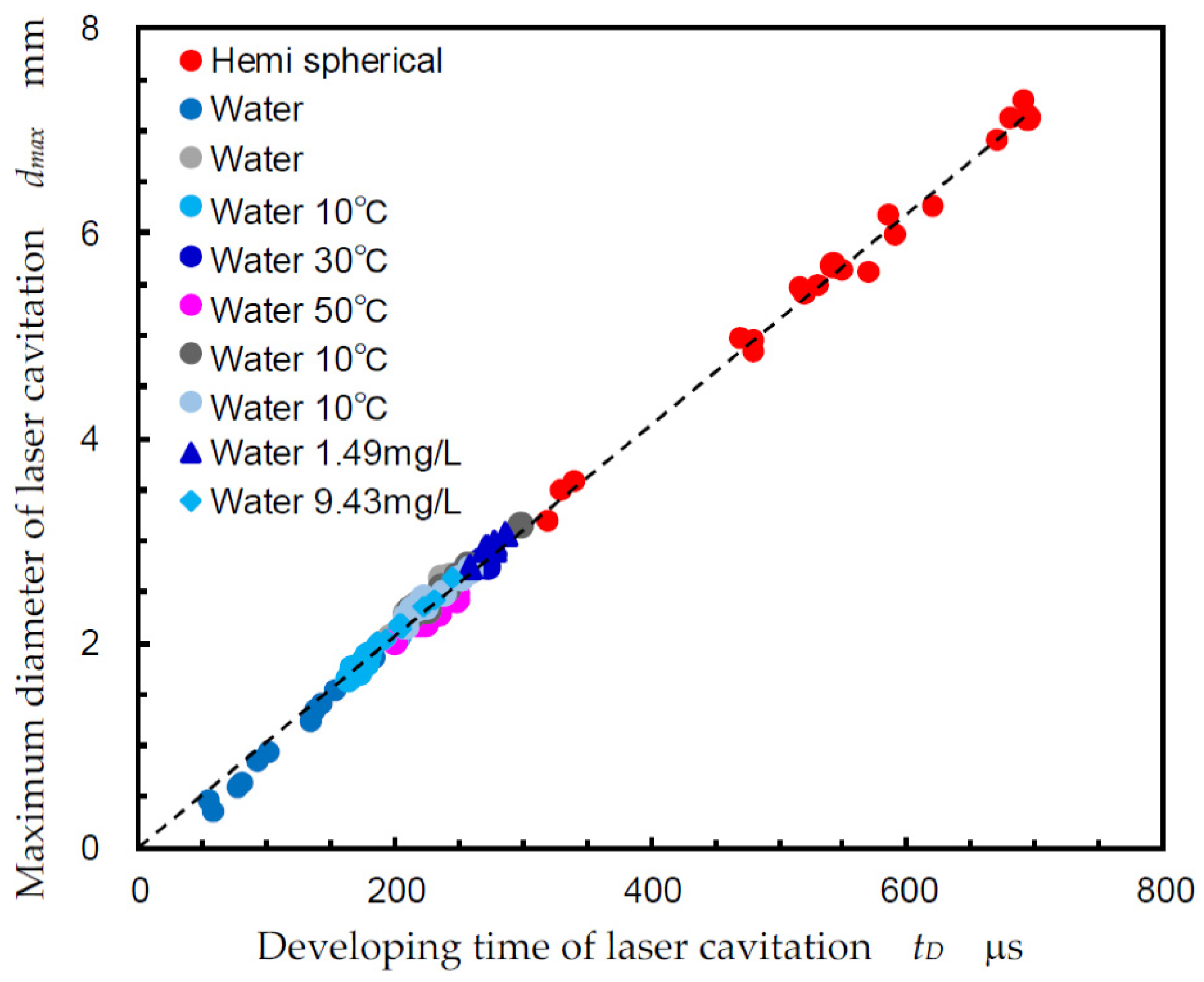


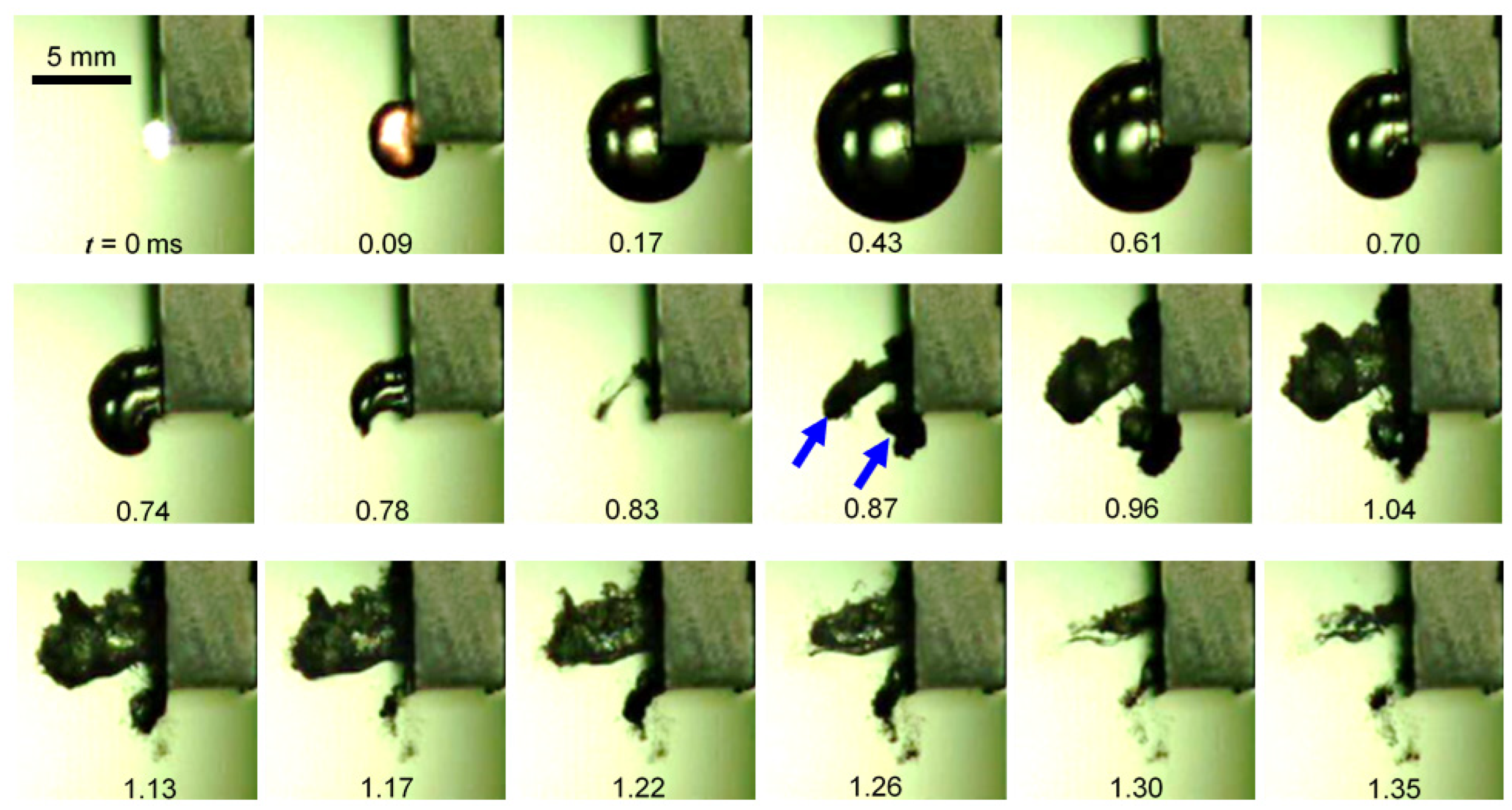
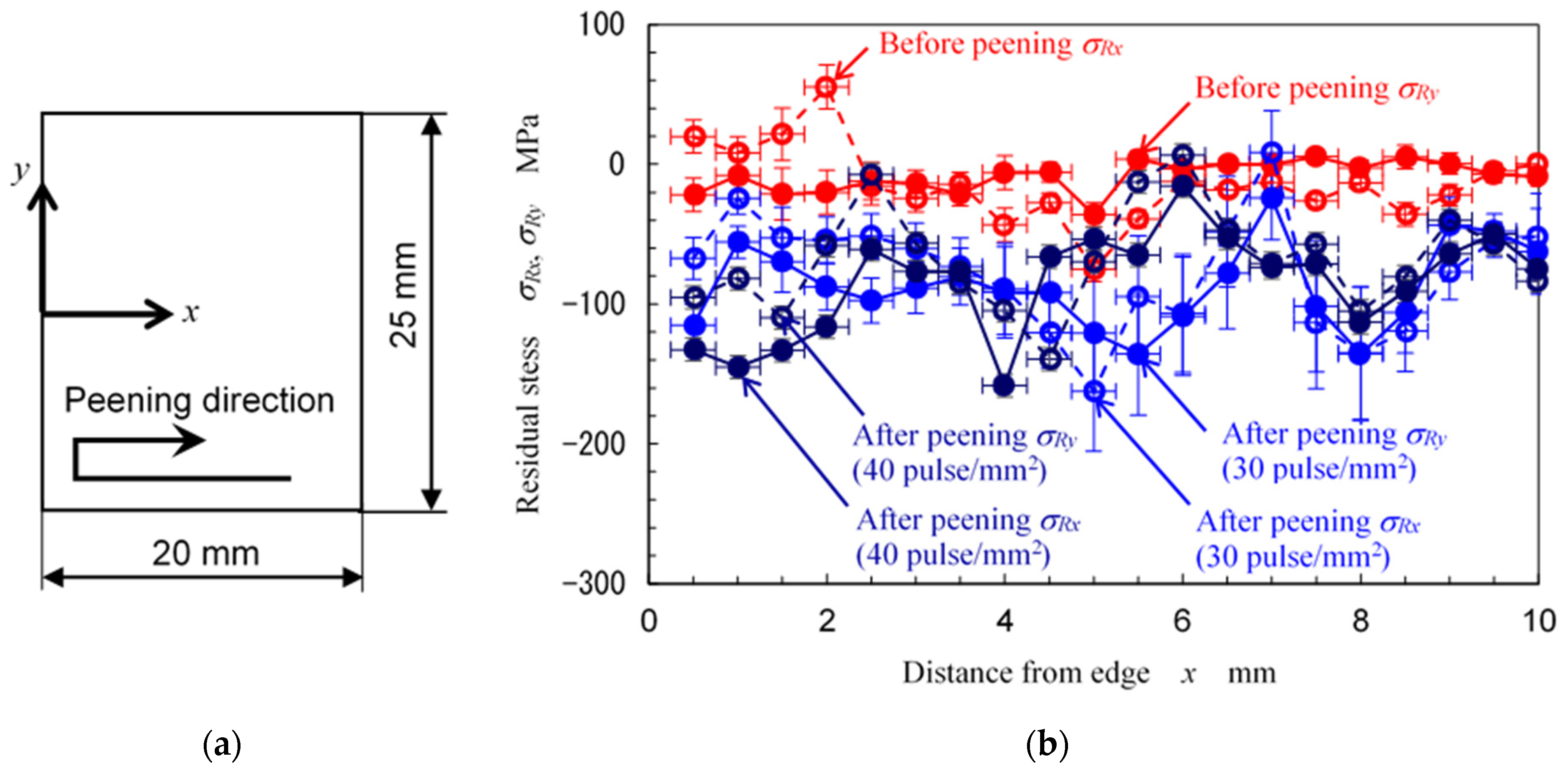

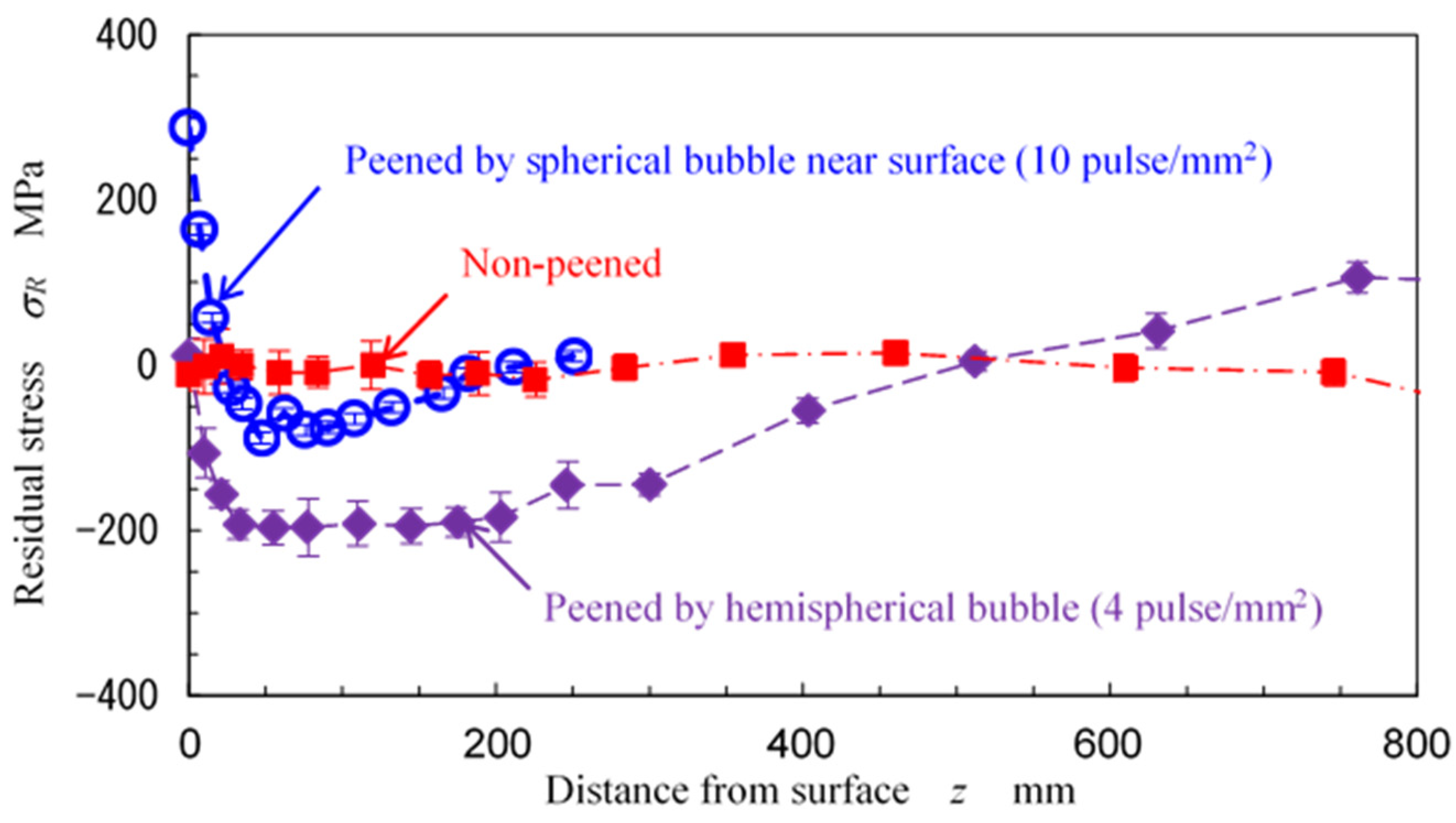
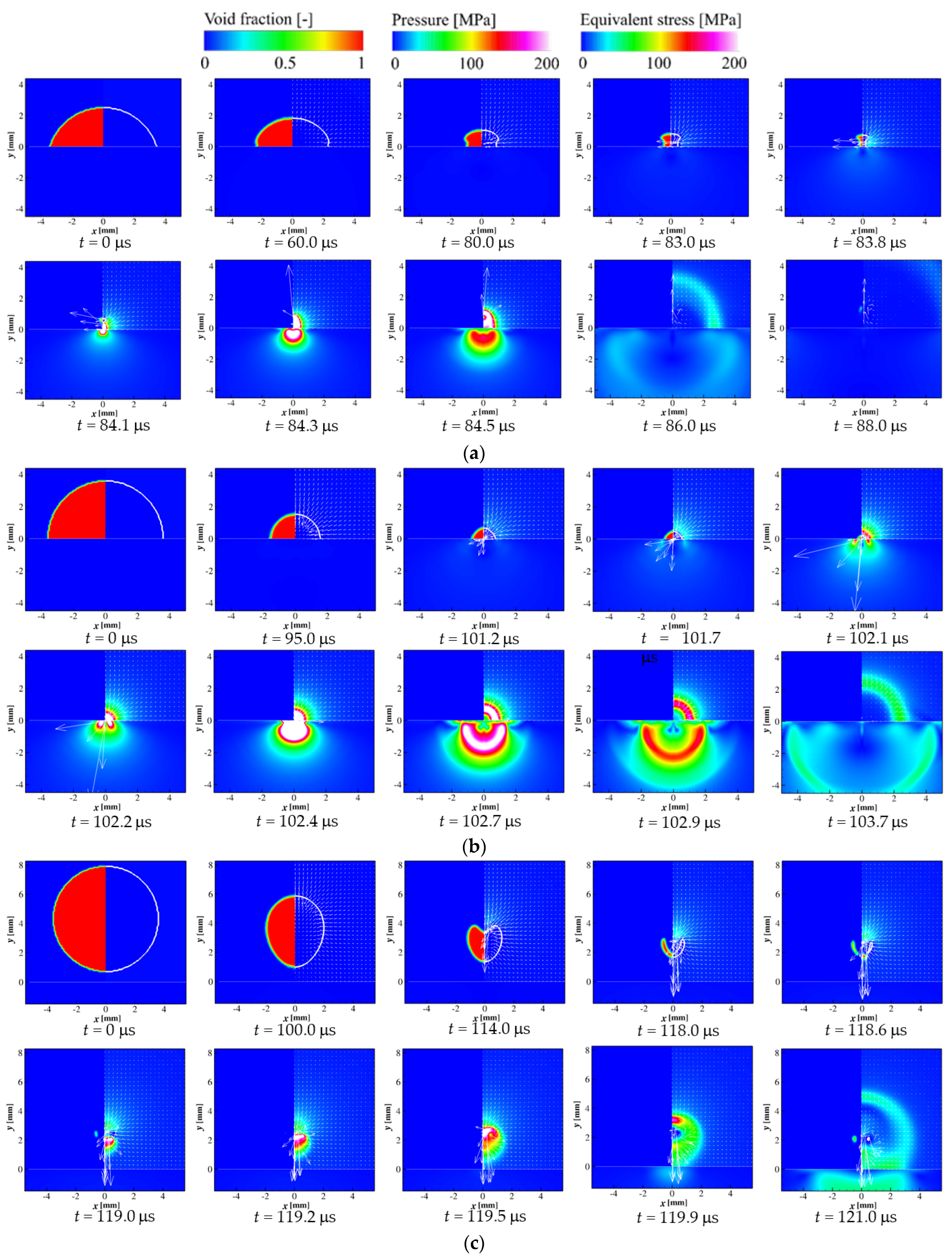

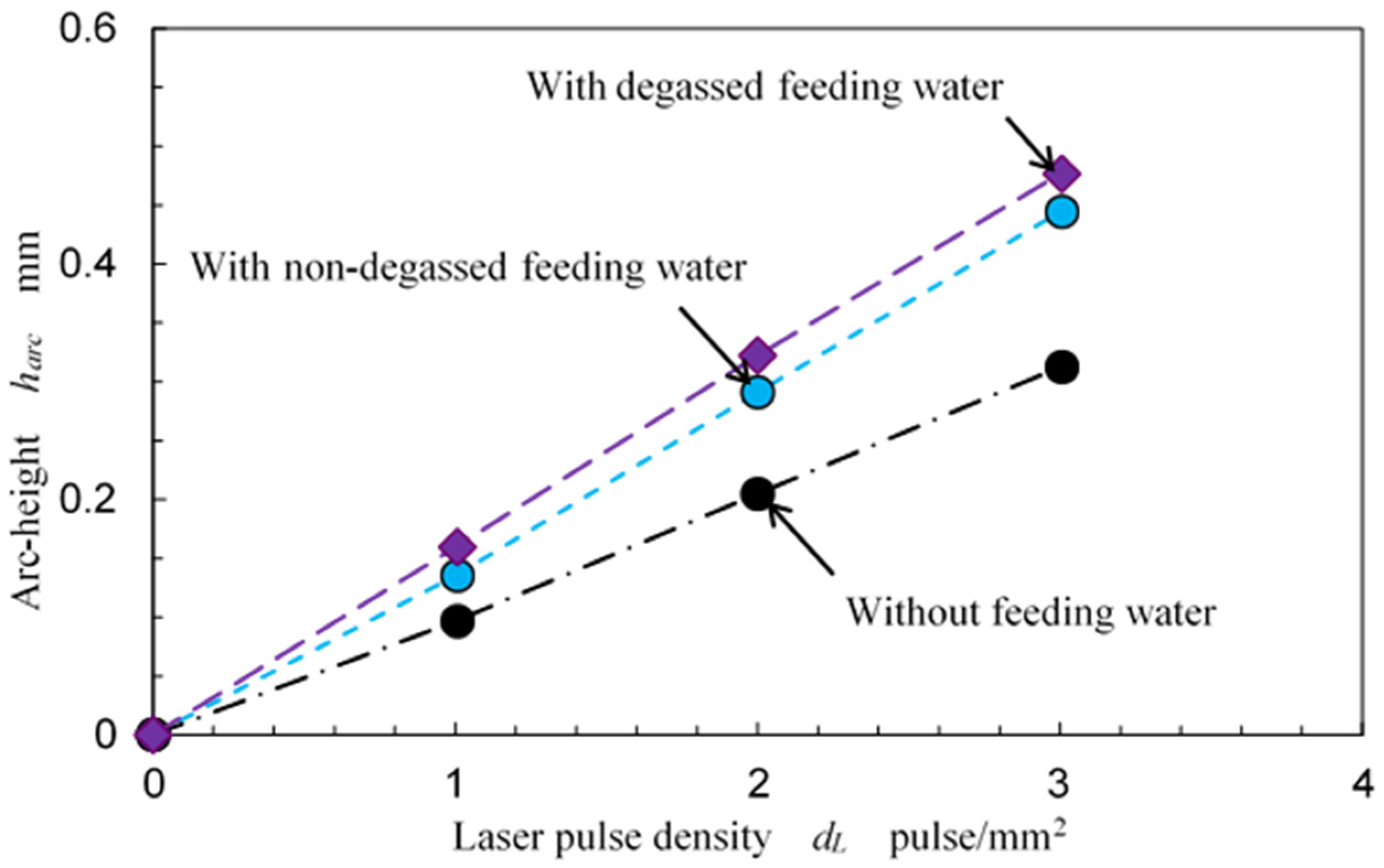
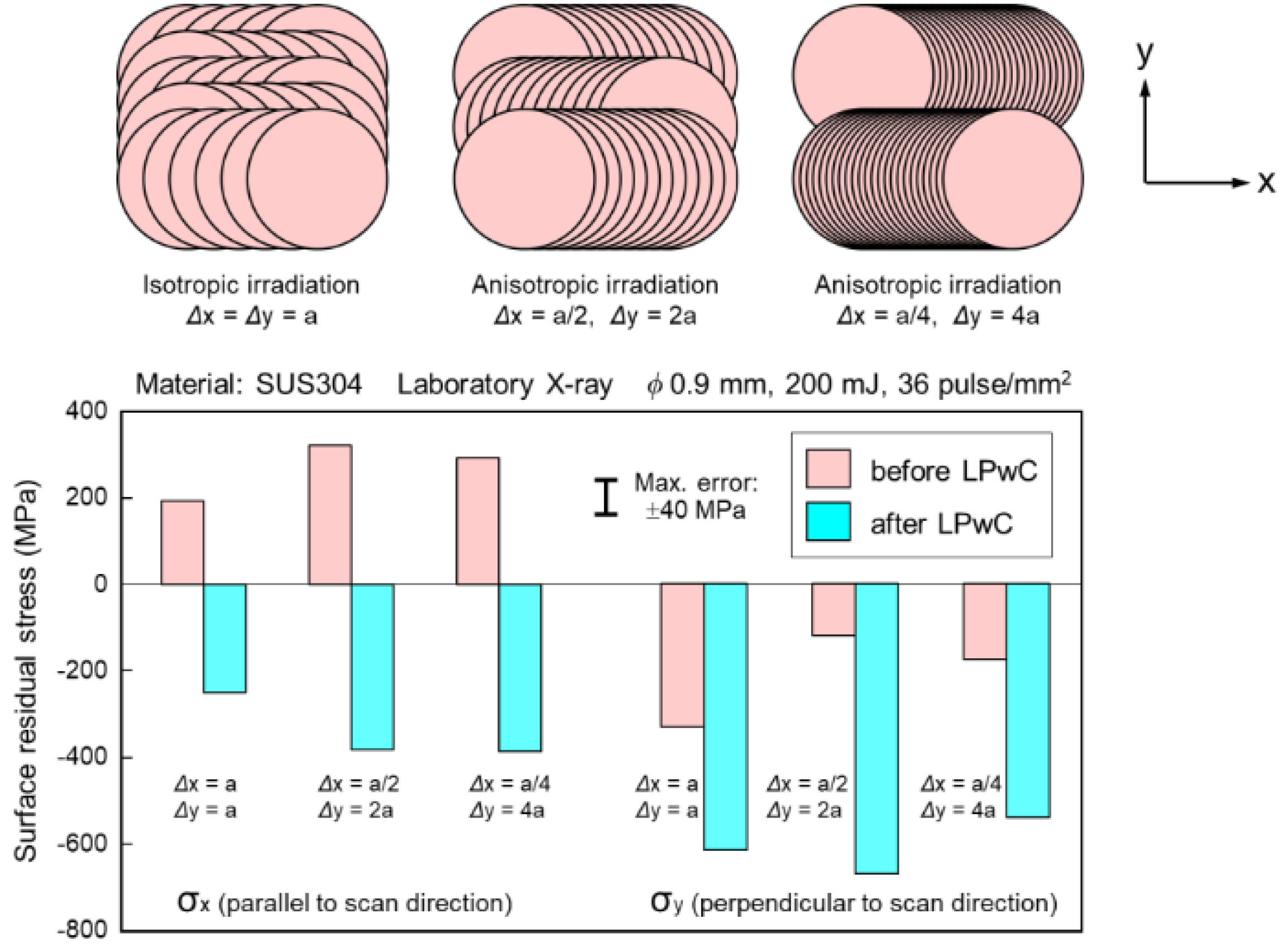
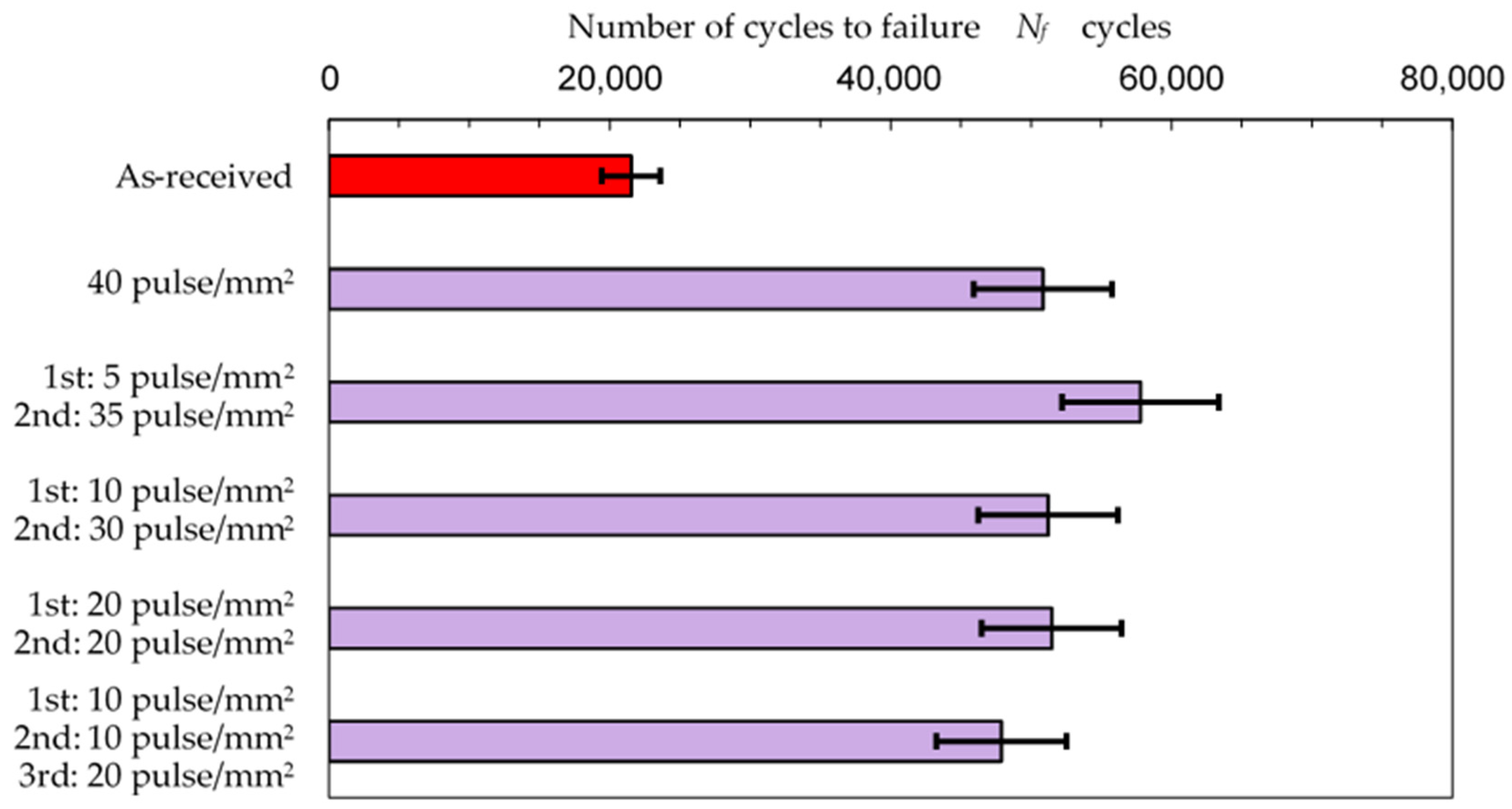

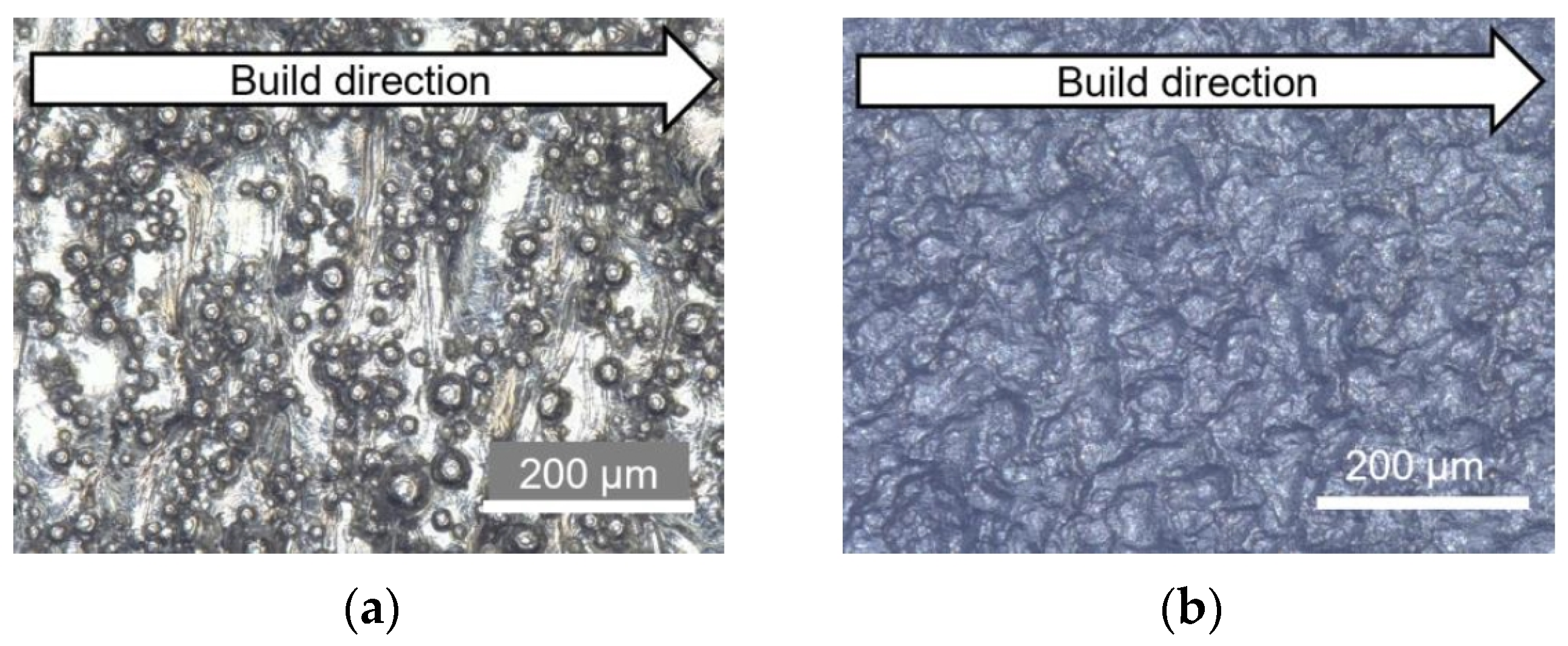
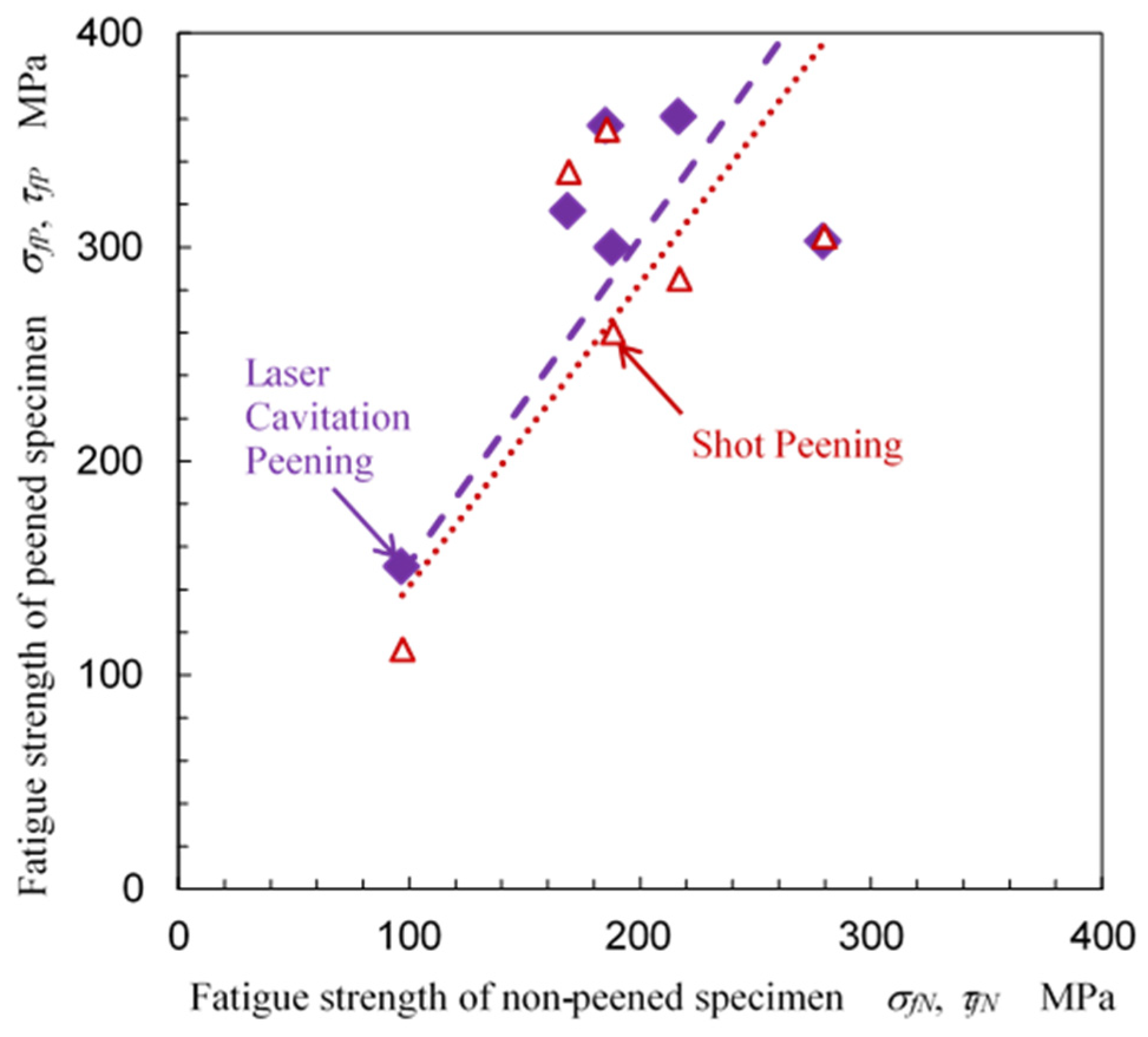
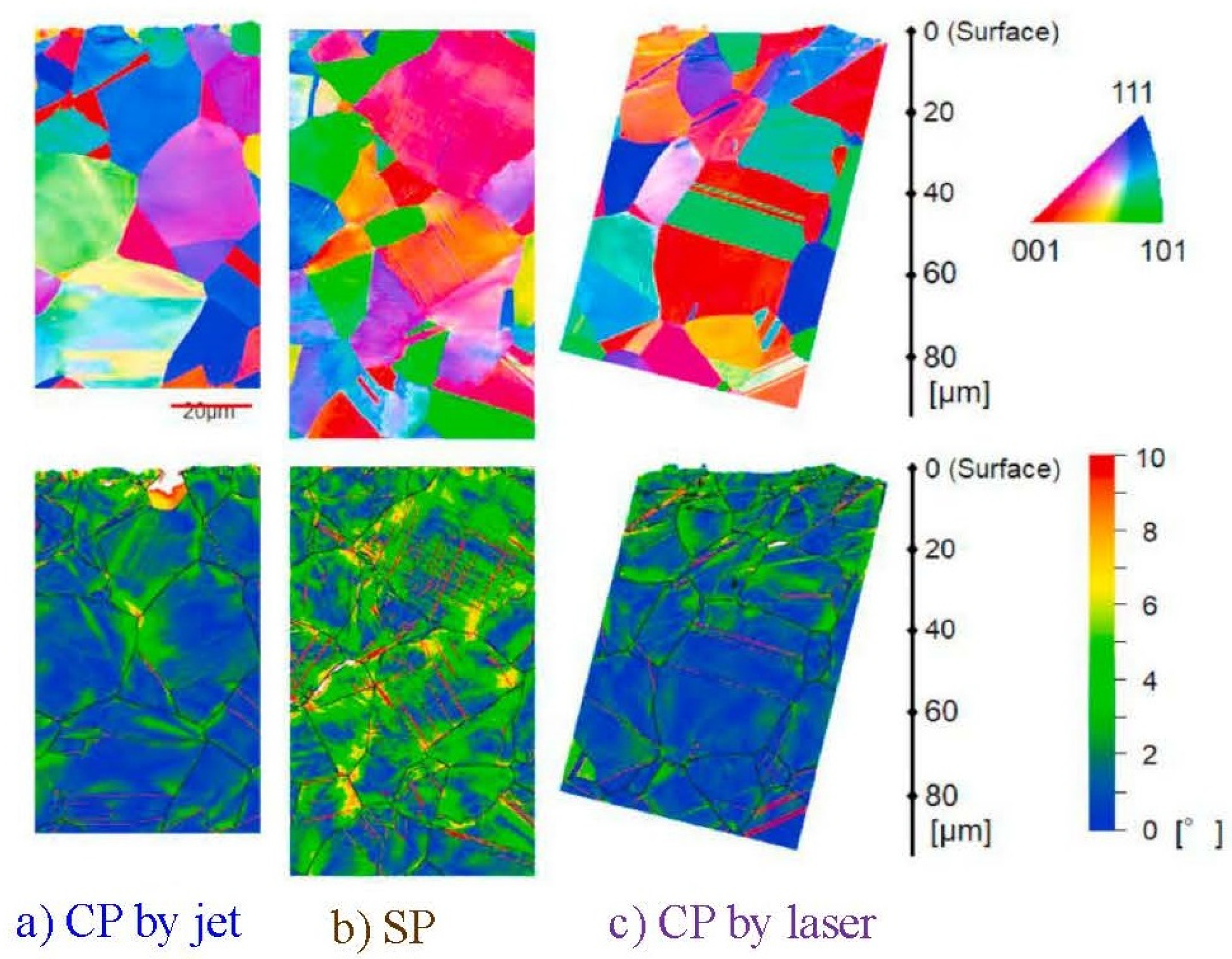
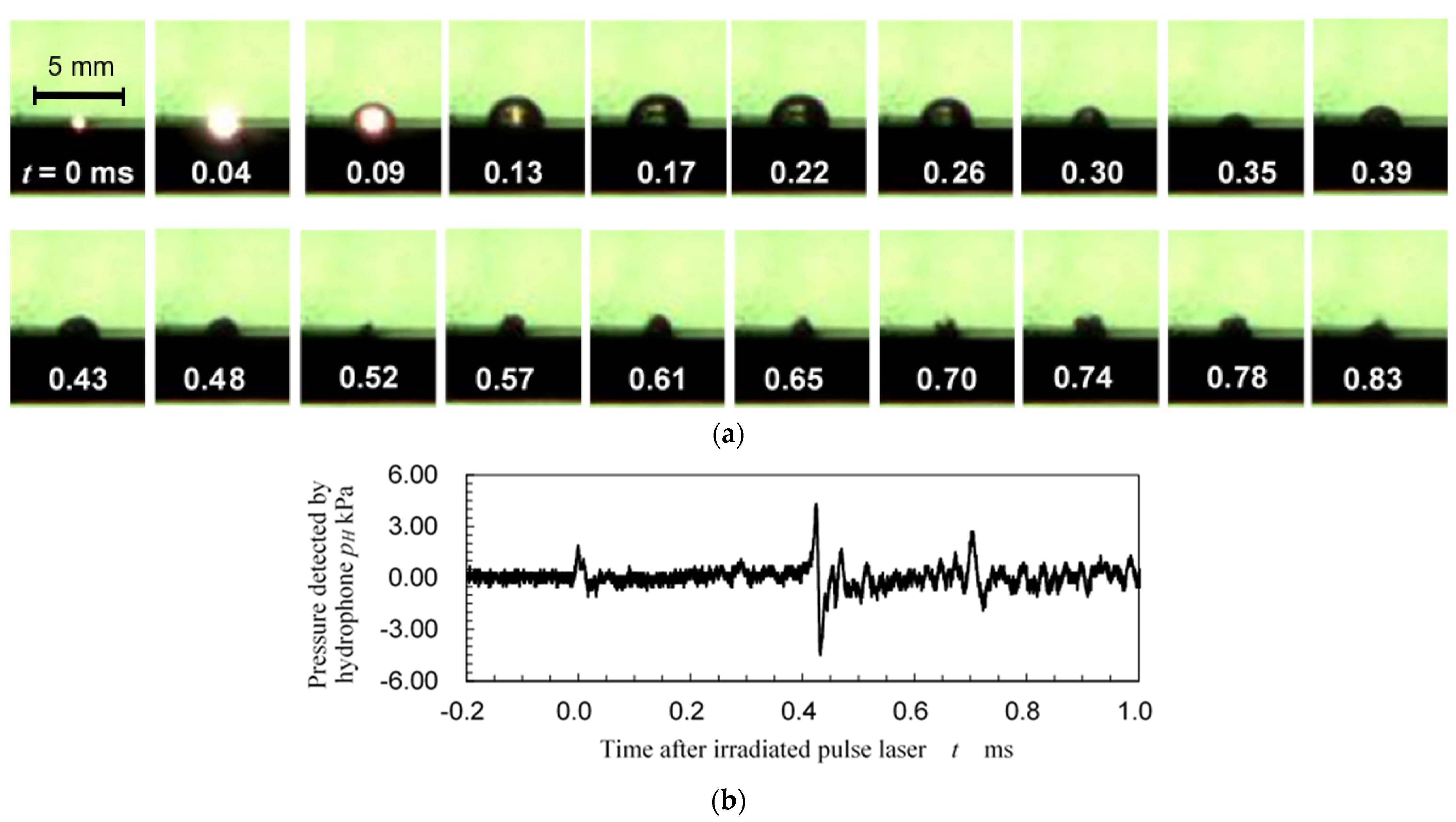
Disclaimer/Publisher’s Note: The statements, opinions and data contained in all publications are solely those of the individual author(s) and contributor(s) and not of MDPI and/or the editor(s). MDPI and/or the editor(s) disclaim responsibility for any injury to people or property resulting from any ideas, methods, instructions or products referred to in the content. |
© 2023 by the authors. Licensee MDPI, Basel, Switzerland. This article is an open access article distributed under the terms and conditions of the Creative Commons Attribution (CC BY) license (https://creativecommons.org/licenses/by/4.0/).
Share and Cite
Soyama, H.; Iga, Y. Laser Cavitation Peening: A Review. Appl. Sci. 2023, 13, 6702. https://doi.org/10.3390/app13116702
Soyama H, Iga Y. Laser Cavitation Peening: A Review. Applied Sciences. 2023; 13(11):6702. https://doi.org/10.3390/app13116702
Chicago/Turabian StyleSoyama, Hitoshi, and Yuka Iga. 2023. "Laser Cavitation Peening: A Review" Applied Sciences 13, no. 11: 6702. https://doi.org/10.3390/app13116702
APA StyleSoyama, H., & Iga, Y. (2023). Laser Cavitation Peening: A Review. Applied Sciences, 13(11), 6702. https://doi.org/10.3390/app13116702







